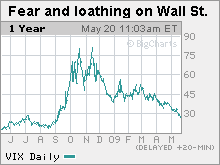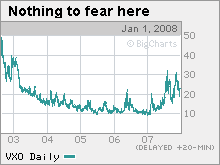Who's afraid of a big bad bear?
Nobody apparently. The drop in the VIX, Wall Street's 'fear gauge,' shows Investors no longer fear an economic meltdown. That's great news.

 |
| The VIX -- aka Wall Street's 'fear gauge' - spiked sharply higher after Lehman Brothers filed for bankruptcy. But the index has fallen in recent months on economic recovery hopes. |
 |
| During the last bull market earlier this decade, volatility was relatively low and remained in a fairly narrow range. |
NEW YORK (CNNMoney.com) -- The market rally keeps chugging along. And even though some are concerned that stocks have moved up too quickly from their March lows, there is one undeniably healthy thing about this surge: Investors are not nearly as afraid about the economy as they were a few months ago.
How do we know this? There is a market barometer called the the CBOE Volatility Index, or VIX for short, that people on Wall Street commonly look at as a gauge of fear. Technically, the VIX (VIX) doesn't really track fear. Instead, it measures market expectations of risk and turmoil.
But the general rule of thumb is that the higher the level of the VIX, the more panicky investors are. On Tuesday, the VIX closed below 30 for the first time in more than eight months.
This is significant when you consider the reason why the VIX had been so elevated as of late: The VIX has not been this low since a little investment bank you may have heard of called Lehman Brothers went kablooey.
The VIX peaked near an all-time high of 90 in late October as investors fretted about the demise of Lehman, subsequent blowup of AIG (AIG, Fortune 500) and the possible nationalization of large banks like Citigroup (C, Fortune 500) and Bank of America (BAC, Fortune 500).
As concerns about an imminent financial meltdown waned, the VIX began to decline. Still, as recently as early March, the VIX was hovering around 50, a level more reflective of dread and anxiety than hope and optimism.
So the fact that the VIX is back near a pre-Lehman level is good news. Sure, it's still probably premature to sound the all-clear and declare that the nation's banks are once again healthy and that the economy is on the upswing.
But if nothing else, people are no longer assuming the worst about the economy. That shift in sentiment is encouraging. Even though the current level of enthusiasm might be a tad unwarranted, investors are compensating for the overdose in negativity from late last year.
"What did the Lehman collapse do? It made us wonder if the financial system would hold up and caused that whole fear of Armageddon," said Linda Duessel, equity market strategist at Federated Investors in Pittsburgh. "I think we don't have to worry about that anymore. The decline in the VIX shows people are less afraid."
Talkback: Are you less afraid of your economic future than you were a few months ago? Leave your comments at the bottom of this story.
Duessel said that as long as the VIX doesn't get too low, then there is a good chance that this recent rally is actually the start of a new bull market and not merely a temporary blip in the bear market. She pointed out that with the VIX around 27, that is still historically high and therefore not a sign of too much exuberance.
To that end, the VIX was mainly in a range of between 10 and 20 from late 2002 through 2007 -- the last bull market. (The CBOE created the VIX in 1993 but made several changes to its methodology in 2003. So for historical data, investors should look at the VXO (VXO) instead.)
David Joy, chief market strategist with RiverSource Investments, a money management firm based in Minneapolis, agreed that the downturn in the VIX is a positive for the market and not yet a cause for concern.
"This is unequivocally good news," Joy said. "This means that the perception of stability is being restored. That's a better environment for investors."
Joy said he'd start to be more worried about the sustainability and longevity of the rally if the VIX began to head much lower than its current level.
"If the VIX gets too low, it could be indicative that good news is already reflected in stock prices. Then you would have to begin to ask yourself what other news could drive stocks higher that investors haven't already discounted," he said.
Doug Roberts, chief investment strategist for ChannelCapitalResearch.com in Shrewsbury, N.J., went one step further. While he concurred that the dip in the VIX so far is a healthy sign of renewed confidence in the markets and economy, he is worried that a further drop could mean investors are getting too complacent and may be ignoring risks.
He said the absolute value of the VIX should be used more as a guide to sentiment and not a predictive tool. After all, the VIX didn't skyrocket above 30 until after Lehman imploded. So if anything, an abnormally low VIX could be a contrarian, bearish indicator.
"A low VIX isn't necessarily a positive," Roberts said. "It could mean that people are getting comfortable and that might set us up to more shocks in the system. Investors might not be factoring bad news into the equation."
Still, as long as the VIX stays in the mid-high 20s, Joy thinks that shows investors are simply realizing that current economic conditions qualify as a recession showing signs of abating, not the beginning of another depression.
"If the VIX recedes at the pace it has without more confirmation that the worst is over for the economy, that would be more of a cause for concern. But as long as the decline tracks the news, you have to feel pretty good about it," he said.
Talkback update: Greetings Buzz readers. There is a new way to post comments for this column. If you have a Facebook account, you can submit your feedback using the Facebook Connect feature that will appear at the bottom of the page. If you don't have one, it is free to sign up.
The good news is that reader comments will now appear immediately and on the same page as the column as opposed to a separate page. I trust that loyal Buzz readers will continue to actively share their thoughts with this new feature. And rest assured, I will still be using the best reader reaction as fodder for video installments of The Buzz.
So with that in mind, here is today's question for readers. Are you less afraid of your economic future than you were a few months ago? ![]()

